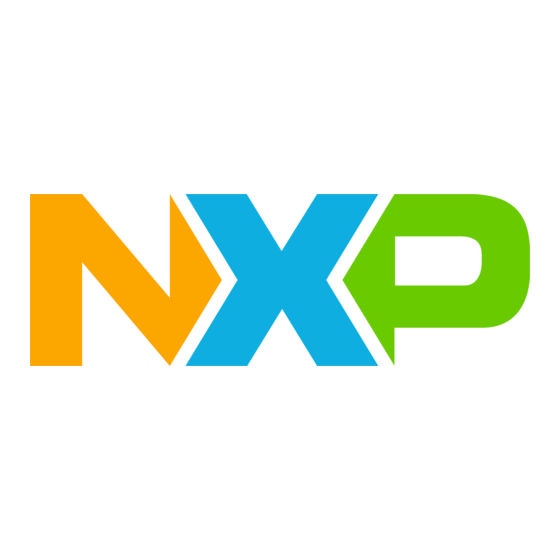
Subscribe to Our Youtube Channel
Summary of Contents for NXP Semiconductors JN5179
- Page 1 UM10955 JN5179-USB-Dongle User Manual Rev. 1.1 — 24 February 2016 User manual Document information Info Content Keywords JN5179, ZigBee, dongle, USB Abstract JN5179 USB dongle user manual...
-
Page 2: Contact Information
Section 4.3: added. Contact information For more information, please visit: http://www.nxp.com UM10955 All information provided in this document is subject to legal disclaimers. © NXP Semiconductors N.V. 2014. All rights reserved. User manual Rev. 1.1 — 24 February 2016 2 of 14... -
Page 3: Fig 1. Jn5179 Usb Dongle (Om15021)
(such as a PC) to a wireless network based on the IEEE802.15.4, ZigBee Smart Energy or ZigBee-Home Automation networking protocol. An FTDI device provides the USB connection between the host machine and the JN5179 device, which in turn provides the radio interface to the wireless network. -
Page 4: Fig 2. Om15021 Board Layout
USB 2.0 Full-Speed Compatible Interface IEEE 802.15.4-based wireless microcontroller (JN5179) with the following radio characteristics: Transmit power: 8.5 dBm (typ.), can be increased to 10 dBm (typ.) Transmit current: 19.6 mA (typ) at 8.5 dBm / 23.3 mA (typ.) at 10 dBm Receive sensitivity: 96dBm (typ.) -
Page 5: Fig 3. Jn5179 Usb Dongle Hardware Blocks
1. Download the application FT_Prog from the FTDI website www.ftdichip.com 2. Insert the JN5179 USB Dongle into a USB port of your computer and wait for the device to enumerate 3. Start FT_Prog and click Scan and Parse (the magnifying glass button) 4. -
Page 6: Fig 4. Io Controls Window
6. On the resulting screen, click Program – see Fig 5 UM10955 All information provided in this document is subject to legal disclaimers. © NXP Semiconductors N.V. 2014. All rights reserved. User manual Rev. 1.1 — 24 February 2016 6 of 14... -
Page 7: Fig 5. Program Devices Window
D2: Off 3. Flash programming When the JN5179 USB dongle is powered up, it attempts to run an application from the internal Flash memory of the JN5179 device. This may be a self-contained application that sends and receives wireless data, and which does not need to communicate with the host. -
Page 8: Compliance Statements And Documentation
In order to program an application binary into Flash memory, the JN51xx Production Flash Programmer can be used, which is described in the JN51xx Production Flash Programmer User Guide (JN-UG-3099). This programming utility will place the JN5179 into its programming mode. It will then download the program to the Flash memory and reset the JN5179 device, causing the application to be executed. -
Page 9: Industry Canada Statement
4.3 Module integration special warnings for US and Canada The JN5179-001-U0 module is considered as component that will be operated in combination with the final equipment. Then, the final equipment (including power supply system) still needs to re-confirm that the whole system complies with intentional and unintentional emission requirements. -
Page 10: Abbreviations
JN5179 JN5179 Data Sheet OM15021_JN5179_USB_Dongle_2V0 OM15021 USB dongle PCB files UM10955 All information provided in this document is subject to legal disclaimers. © NXP Semiconductors N.V. 2014. All rights reserved. User manual Rev. 1.1 — 24 February 2016 10 of 14... -
Page 11: Legal Information
Translations — A non-English (translated) version of a document is for reference only. The English version shall prevail in case of any discrepancy In no event shall NXP Semiconductors be liable for any indirect, incidental, between the translated and English versions. -
Page 12: Table Of Contents
JN5179 USB dongle (OM15021) ...... 3 Fig 2. OM15021 board layout ........4 Fig 3. JN5179 USB dongle hardware blocks ....5 Fig 4. IO controls window ..........6 Fig 5. Program devices window ........7 UM10955 All information provided in this document is subject to legal disclaimers. -
Page 13: List Of Tables
DIO control of LEDs .......... 7 Table 2. Abbreviations ..........10 UM10955 All information provided in this document is subject to legal disclaimers. © NXP Semiconductors N.V. 2014. All rights reserved. User manual Rev. 1.1 — 24 February 2016 13 of 14... -
Page 14: Contents
Dongle layout ............. 4 Dongle block diagram ........5 Hardware components ........5 2.3.1 JN5179 device ........... 5 2.3.2 FT230XS device ..........5 2.3.3 LEDs ..............7 ...


Need help?
Do you have a question about the JN5179 and is the answer not in the manual?
Questions and answers